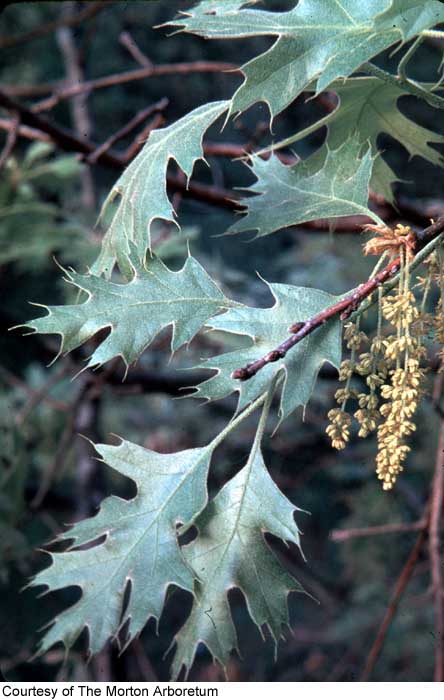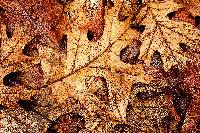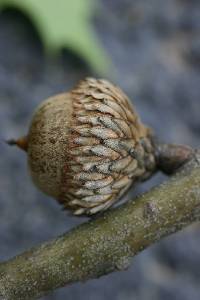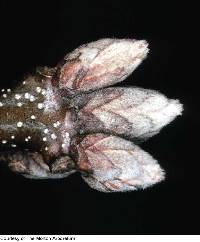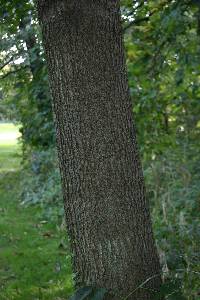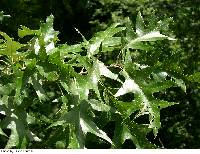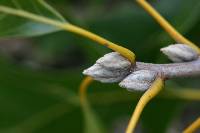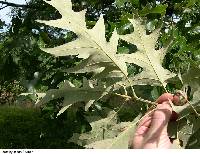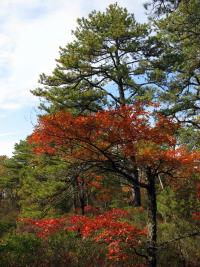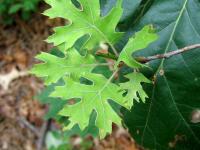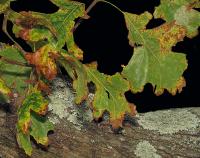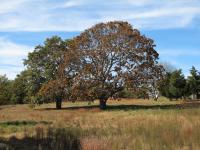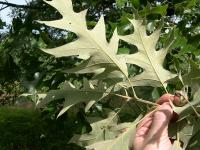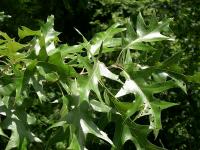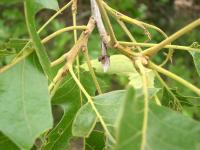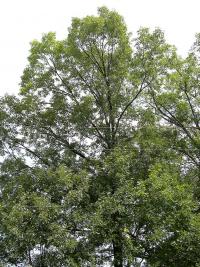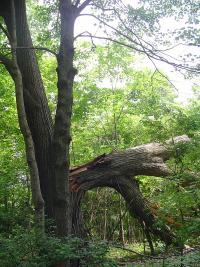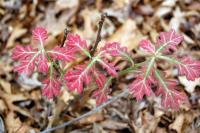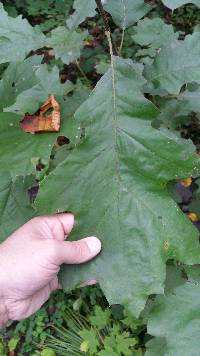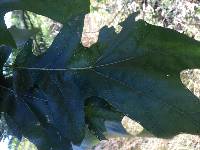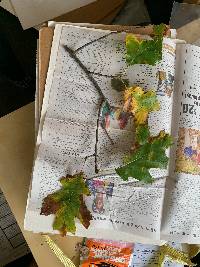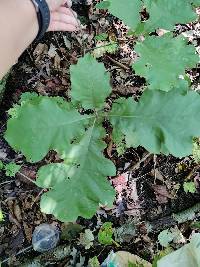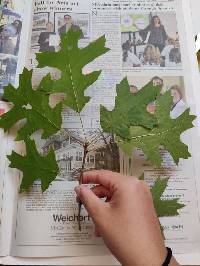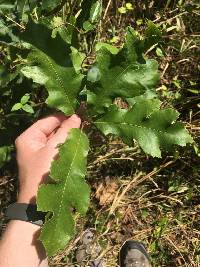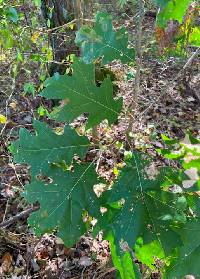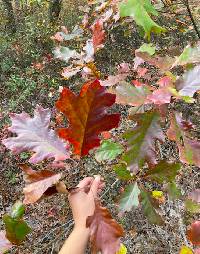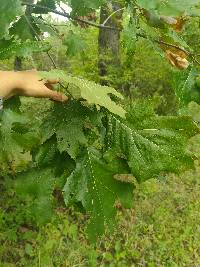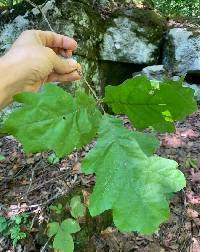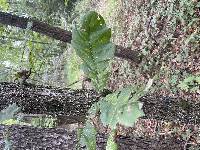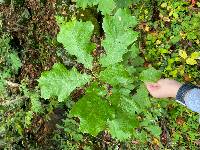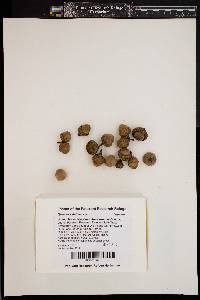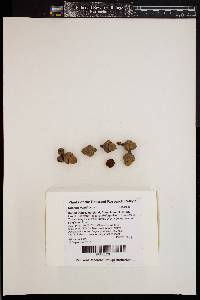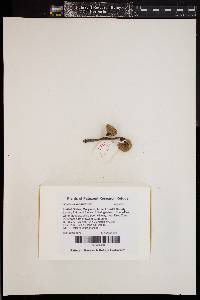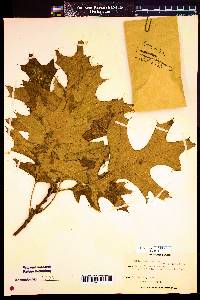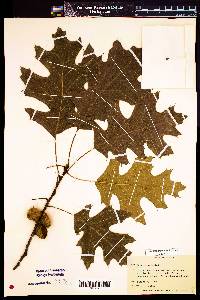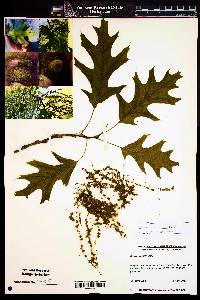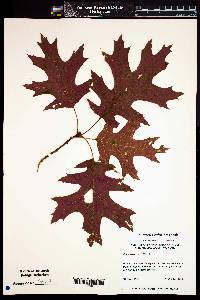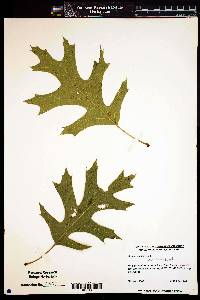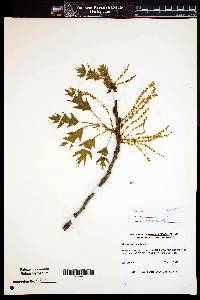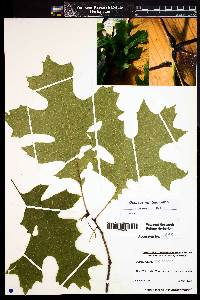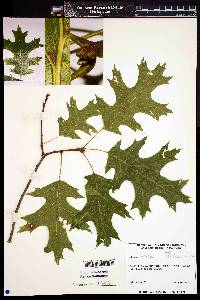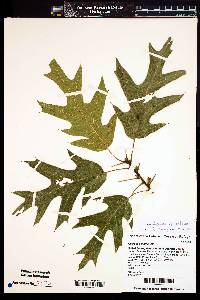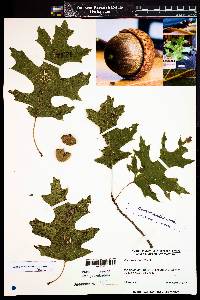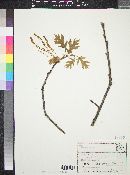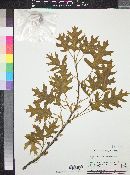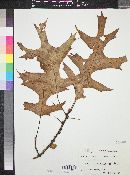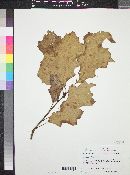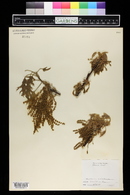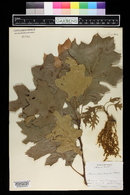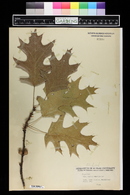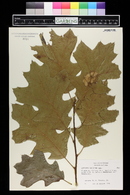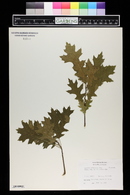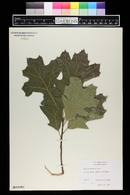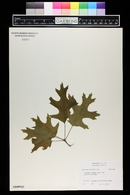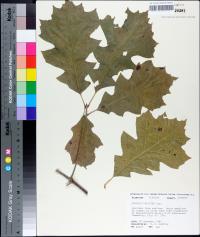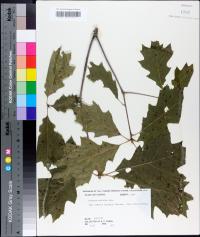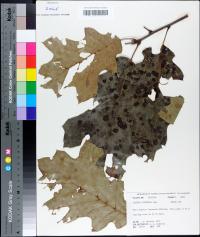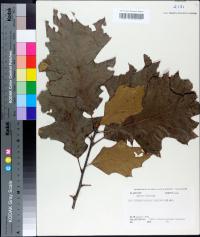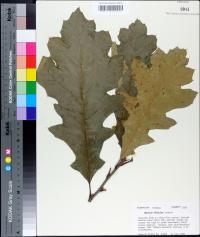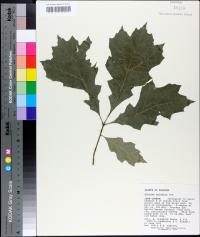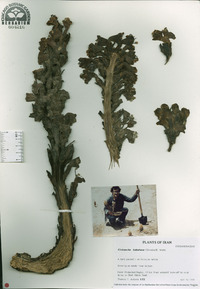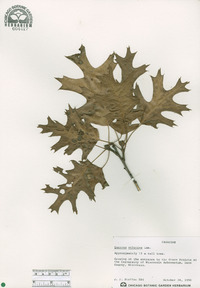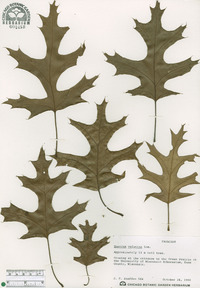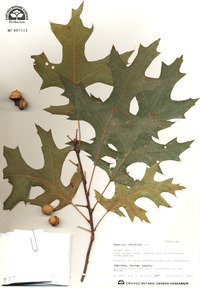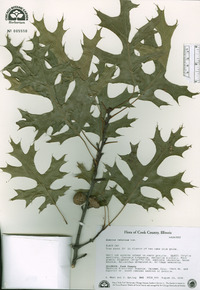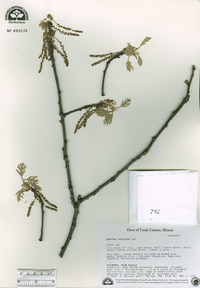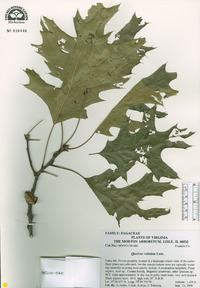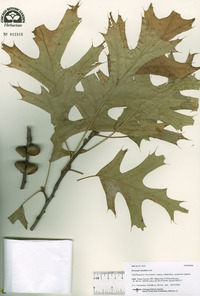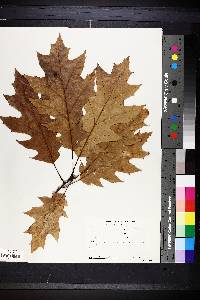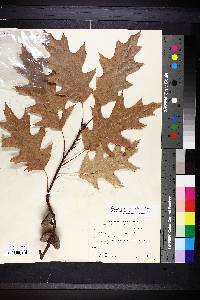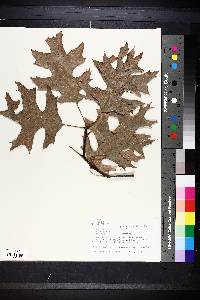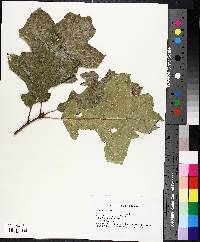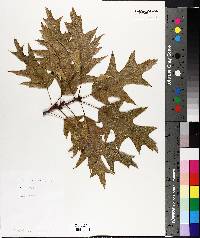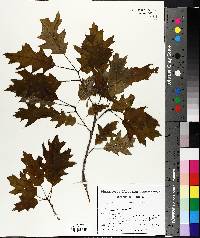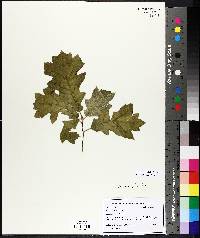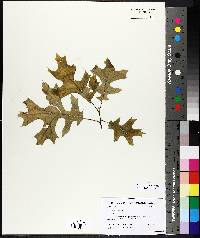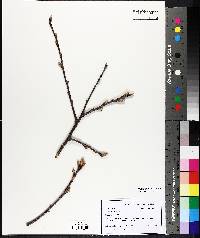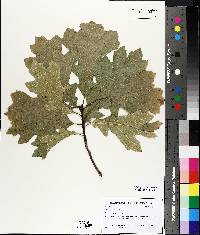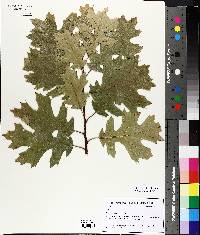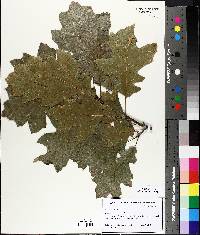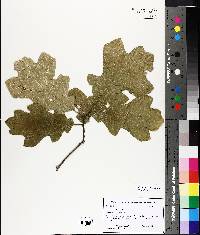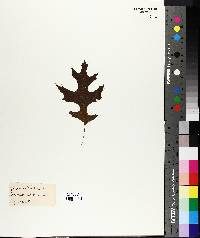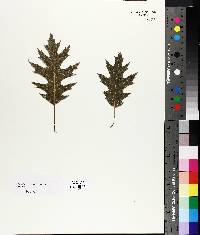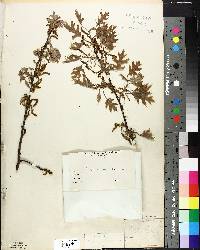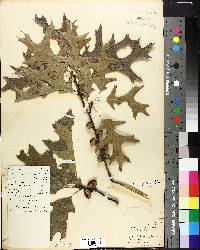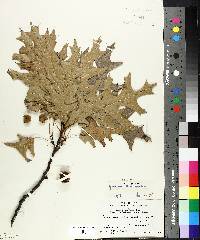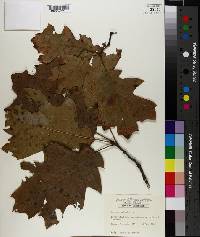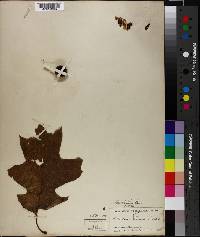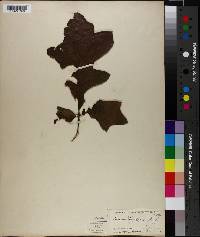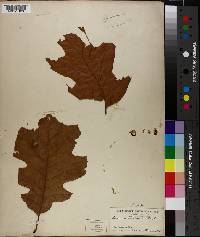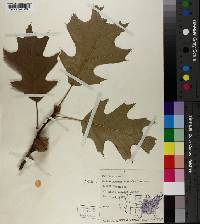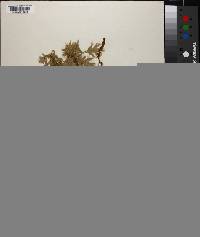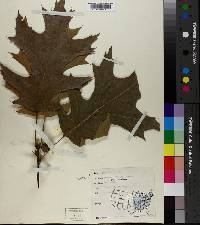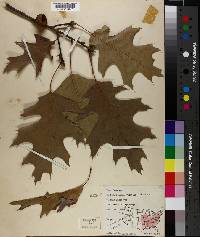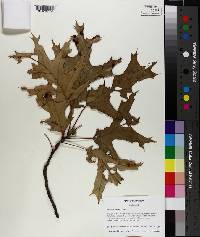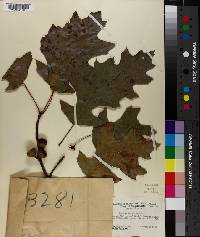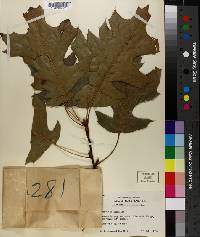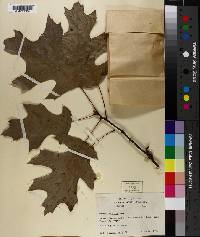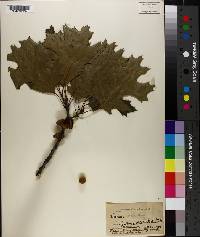Quercus velutina
|
|
|
|
Family: Fagaceae
Black Oak
[Quercus coccinea var. tinctoria, moreQuercus velutina f. missouriensis (Ashe) Trel., Quercus velutina var. missouriensis Sarg.] |
Trees , deciduous, to 25 m. Bark dark brown to black, deeply furrowed, ridges often broken into irregular blocks, inner bark yellow or orange. Twigs dark reddish brown, (1.5-)2.5-4.5(-5) mm diam., glabrous or sparsely pubescent. Terminal buds ovoid or ellipsoid to subconic, 6-12 mm, noticeably 5-angled in cross section, tawny- or gray-pubescent. Leaves: petiole 25-70 mm, glabrous to sparsely pubescent. Leaf blade ovate to obovate, (80-)100-300 × 80-150 mm, base obtuse to truncate, inequilateral, margins with 5-9 lobes and 15-50 awns, lobes oblong or distally expanded, separated by deep sinuses, apex acute to obtuse; surfaces abaxially pale green, glabrous except for small axillary tufts of tomentum or with scattered pubescence, especially along veins, adaxially glossy, dark green, glabrous, secondary veins raised on both surfaces. Acorns biennial; cup cup-shaped or turbinate, 7-14 mm high × 12-22 mm wide, covering 1/2 nut, cup margins not involute, outer surface puberulent, inner surface pubescent, scale tips loose, especially at margin of cup, acute to acuminate; nut subglobose to ovoid, 10-20 × 10-18 mm, glabrate, scar diam. 5.5-12 mm. n = 12 ± 1; 2 n = 24. Flowering spring. Commonly on dry slopes and upland areas, occasionally on sandy lowlands (especially in north) and poorly drained uplands and terraces; 0-1500 m; Ont.; Ala., Ark., Conn., Del., D.C., Fla., Ga., Ill., Ind., Iowa, Kans., Ky., La., Maine, Md., Mass., Mich., Minn., Miss., Mo., Nebr., N.H., N.J., N.Y., N.C., Ohio, Okla., Pa., R.I., S.C., Tenn., Tex., Vt., Va., W.Va., Wis. The bark of this species (quercitron) is rich in tannins and was once an important source of these chemicals used for tanning leather. (The yellow dye obtained from the bark is also called quercitron.) Native Americans used Quercus velutina medicinally for indigestion, chronic dysentery, mouth sores, chills and fevers, chapped skin, hoarseness, milky urine, lung trouble, sore eyes, and as a tonic, an antiseptic, and an emetic (D. E. Moerman 1986). Quercus velutina reportedly hybridizes with Q . coccinea , Q . ellipsoidalis (= Q . × paleolithicola Trelease), Q . falcata [= Q . × willdenowiana (Dippel) Zabel] (= Q . × pinetorum Moldenke)], Q . ilicifolia (= Q . × rehderi Trelease), Q . imbricaria (= Q . × leana Nuttall), Q . incana , Q . laevis , and Q . laurifolia (= Q . × cocksii Sargent, although E. J. Palmer [1948] challenged the validity of this claim), Q . marilandica , Q . nigra , Q . palustris (= Q . × vaga E. J. Palmer & Steyermark), Q . phellos (= Q . × filialis Little), Q . rubra , Q . shumardii , and possibly Q . arkansana (D. M. Hunt 1989).
Tree 18 - 25 m tall, trunk to 1.3 m in diameter Leaves: alternate, stalked, shiny dark green above, paler to yellowish brown beneath, 10 - 20 cm long, 8 - 12 cm wide, nearly square at base, five to nine (usually seven) bristle-tipped lobes separated by depressions extending to half the distance to midvein or deeper. Flowers: either male or female, borne on the same tree (monoecious), reddish male flowers borne in hanging catkins 10 - 15 cm long, red female flowers borne in small clusters near leaf axils. Fruit: an acorn, maturing in two seasons, solitary or in pairs. The short-stalked cup is shaped like a deep bowl, covers one-third to half of the nut, and has brown, thin, loosely overlapping, short-haired scales with slightly fringed margins. Nut reddish brown, 1.2 - 2 cm long, egg-shaped, often downy. Bark: dark brown and smooth, becoming almost black and developing blocks with deep furrows and horizontal cracks. The inner bark is bright orange or yellow. Twigs: with or without hairs the first year, becoming dark reddish brown to mottled gray and hairless. Buds: gray, 6 - 8 mm long, conical to angled with sharply pointed tips and densely hairy scales. Each terminal bud is surrounded by a cluster of lateral buds. Form: wide-spreading, rounded to irregular with slender branches. Similar species: Many species in the red oak group have highly variable, lobed leaves with bristle tips. Quercus rubra has shallowly lobed leaves with a somewhat dull upper surface and a very shallow saucer-shaped acorn cup that covers only the base of the nut. The leaves of Quercus shumardii have depressions reaching three-quarters the distance to the midvein, the tufts of hairs at the leaf axils are very prominent, the buds are grayish to yellow, and the acorn cup is saucer-shaped and covers one-third of the nut. Quercus palustris has leaves with U-shaped depressions reaching three-quarters the distance to the midvein, dead branches remaining on the trunk, and a shallow acorn cup covering the base of the small nut. Quercus ellipsoidalis has leaves with depressions reaching three-quarters the distance to the midvein, dead branches remaining on the trunk, and an acorn cup enclosing up to half of the often elliptic nut. Quercus coccinea has leaves with C-shaped depressions reaching half the distance to the midvein, inner bark that is pink to red, and a reddish brown to orange acorn cup that covers one-third to half the nut, which has concentric rings at the tip. Flowering: mid April to early June Habitat and ecology: Commonly located on well-drained slopes, in sandy areas, dunes, and open woodlands and savannas where fire occurs. Occurence in the Chicago region: native Notes: Quercus velutina has tannins in its bark that were once used to tan leather. The bark is also used for its natural yellow dye. The trees are usually poorly shaped for lumber production, but are occasionally sold as red oak. Quercus velutina naturally hybridizes with Q. coccinea (Q. x fontana), Q. rubra (Q. x hawkinsii), Q. imbricaria (Q. x leana), Q. ellipsoidalis (Q. x palaeolithicol) and Q. palustris (Q. x vaga). Etymology: Quercus is the Latin name for oak. Velutina comes from the Latin word for velvet-like. Author: The Morton Arboretum Tree to 40 m, with very dark, rough bark, the inner bark yellow or orange; lvs glossy, shallowly or deeply lobed, pubescent in the vein-axils beneath, otherwise glabrous or persistently and loosely stellate over the lower surface and along the midvein above, the petioles and twigs of the season commonly thinly hairy; buds 4-angled, densely pubescent, 7-10 mm; acorns 1.5-2 cm, the cup turbinate, covering half the nut, wholly hairy inside, the scales relatively few and large, pubescent, the uppermost loose, prominently projecting and forming a marginal fringe. Usually in dry or sterile upland soil and on dunes; s. Me. to Mich. and se. Minn., s. to Fla. and Tex. Gleason, Henry A. & Cronquist, Arthur J. 1991. Manual of vascular plants of northeastern United States and adjacent Canada. lxxv + 910 pp. ©The New York Botanical Garden. All rights reserved. Used by permission. From Flora of Indiana (1940) by Charles C. Deam This species is without doubt found in every county of the state. In abundance, it ranks next to white oak, with which it is generally associated, except in very poor soil where it will be the only species or associated with post and chestnut oaks. It prefers a dry soil and is generally found on sandy and clayey ridges. …… Indiana Coefficient of Conservatism: C = 4 Wetland Indicator Status: N/A Deam (1932): In Floyd and Harrison counties are certain small aareas which were known to the early settlers as the "barrens." These areas were treeless. They were covered with a growth of some sort of oak which the natives call "scrub" oak, hazel, and wild plum. The height of the growth in any part would "not hide a man on horse back." These areas are now all under cultivation, and are no longer distnguished from the forested areas. However, many parts of the barrens are now covered with forests, but these forests are a complete stand of black oak. Recently one of these areas was cut off, and the age of the trees was ascertained to be about 65 years. The barrens of southern Indiana and adjacent states offer a good problem for ecologists. Wood similar to that of red oak, but often much inferior. The uses of the best grades of black oak are practically the same as those of red oak. Where the black and scarlet oak are associated, the scarlet oak is rarely separated from it. The two species superficially much resemble each other. The black oak is always easily distinguished by cutting into the inner bark which is yellow, while that of scarlet oak is gray or reddish. The inner bark imparts a yellow color to spittle, and the scarlet does not. When mature fruiting branches are at hand they may be separated by the appearance of the fruit. The scales of the cups of the black oak are rather dull and loosely imbricated near the top while those of the scarlet oak are rather glossy and closely imbricated. The scales of the scarlet oak, however, become somewhat loose some time after the fruit has matured and fallen. This species is sometimes called yellow oak. Since the chinquapin oak is also often called yellow oak, it is best to always call this species black oak. |
|
|
|

